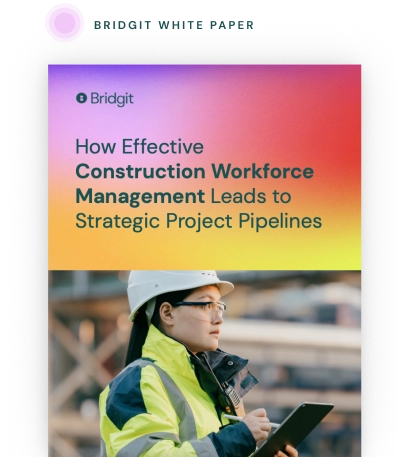The term “preconstruction” describes activities undertaken in preparation for a construction project’s full launch. Keep reading as we discuss preconstruction, its various activities, and why it’s such an important investment for construction companies.
Table of Contents
What is preconstruction?
Pre-construction encompasses all activities that take place before the formal start of a construction project. The preconstruction activities list includes:
- understanding what the client needs
- defining the project’s scope
- estimating the project’s cost
- assessing the project’s feasibility
- flagging potential issues with the project
- identifying and acquiring the necessary permits
These activities aren’t necessarily undertaken by the general contractor. Rather, as with many other parts of a construction project, preconstruction is often subcontracted out.
Following the preconstruction process, all stakeholders (including the owner and general contractor) should understand whether the project is worth proceeding with.
Exploring the preconstruction process in greater detail
Next, let’s take a closer look at each item on the aforementioned preconstruction activities list.
Understanding what the client needs
At the very start of every preconstruction process, it helps to have an understanding of what the project’s owner is requesting. That’s the focus of this stage, during which the involved parties review documentation from the client and make any requests for information (RFIs) as required.
If allowed and applicable, the involved parties may also inspect the job site or existing structure to better understand the client’s requirements.
Defining the project’s scope
The client’s needs may not always align with a sensible project scope. That’s where this stage comes into play. In it, the contractor conducting preconstruction activities will determine a reasonable project scope that gets the client as close as possible to their ideal state in an efficient manner.
Estimating the project’s cost
The next stage in the preconstruction process entails estimating the project’s cost. The outcome of this exploration is essential for understanding whether the project is feasible and worth proceeding with.
Contractors use a variety of strategies during the estimating process, including:
- referencing past projects with comparable requirements
- receiving quotes from subcontractors and material suppliers
- determining the profit they would likely earn during the project
Assessing the project’s feasibility
After analyzing the project’s scope and estimating its cost, the next step for a preconstruction contractor is to determine whether the project is feasible. If it’s not, the contractor may propose adjustments to the project’s requirements and scope that should bring it within the realm of feasibility.
Flagging potential issues with the project
This next stage in the preconstruction process is closely related to the previous one. During it, the contractor conducting preconstruction activities will highlight potential challenges. The issues underlying these challenges might range in type from environmental to regulatory or anything in between.
While highlighting these challenges to other stakeholders, the preconstruction contractor will likely propose solutions or attempt to reach some other agreement that will allow the project to proceed.
Acquiring the necessary permits
This is among the final stages in the preconstruction process. In it, the contractor overseeing these activities may acquire the necessary permits in order for the project to commence. This often takes place during the preconstruction process since delays in acquiring permits would otherwise bring the entire project to a halt.
Benefits of a well-planned preconstruction process
Preconstruction can take lots of time. Here’s why savvy construction professionals and project owners see it as a worthwhile investment.
Improved foresight into potential project issues
Preconstruction planning provides advance warning about issues that may arise once the project begins. This gives professionals time to identify and implement solutions (or pull out of the project altogether if those issues are insurmountable and speak to feasibility challenges).
Without a comprehensive preconstruction process, stakeholders might only become aware of substantial issues once the project is already well underway. At that point, it may be incredibly difficult (and expensive) to change course, whereas making adjustments during the preconstruction phase might’ve been easier.
Better estimating and management of project financials
As mentioned earlier, estimating is a key part of the preconstruction process. And, as many construction managers know, good estimating is essential not only for the project’s success but also that for the entire company. Indeed, according to an Intuit study, 25% of construction firms describe themselves as being just two to three inaccurate estimates away from going under.
Improved stakeholder engagement
The preconstruction process is a time for various stakeholders (from the owner to general contractor and subcontractors) to be involved in determining how the project proceeds. This should result in improved stakeholder engagement throughout the entire project.
Increased likelihood of project success
The aforementioned benefits of a comprehensive preconstruction process contribute to arguably the biggest goal for any construction company: ensuring project success.
The preconstruction process gives professionals many opportunities to be proactive and address potential project issues before they arise.
Elevate your preconstruction process with Bridgit Bench
Bridgit Bench is the leading construction resource management software in North America. It includes many features that assist in the preconstruction process, including:
- Resource management forecasting: predict your company’s resource requirements and capabilities throughout the project lifecycle
- Project database management: track important information about your project and quickly see all of your company’s upcoming and ongoing projects at a glance. Streamline work assignment efficiency with insights into allocations and historical data.
- Reporting: pull and easily compare reports from prior projects to your current undertaking to create more accurate estimates
- Remote planning: take your preconstruction activities into the cloud with our fully remote solution; enter data from the field with just a few taps
To learn more about Bridgit Bench and its capabilities, visit this page. You can also sign up for a demo of our platform.

Use your workforce data to create a competitive advantage
Download our white paper to see how effective workforce planning can help stay ahead of labor demands and create a strategic project pipeline.
What is preconstruction? Conclusion
Preconstruction is a process that consists of all activities undertaken before a construction project’s formal start. During the preconstruction process, contractors conduct their due diligence and ensure they have the information and awareness required to proceed confidently with the project. We hope this article has helped you understand the preconstruction process and what it entails. Visit our blog for more articles about construction project and resource management.


